
Best Android Os For PC Archives

Best Android Os For PC Archives
Android is the most popular mobile operating system in the world, but just because it’s meant for mobile doesn’t mean it can’t be installed on the desktop. There are many ways to get Android running on a PC, including virtual device emulators, bootable USB versions, and even full standalone applications like BlueStacks. Each has its advantages and disadvantages depending on your needs. Here is the full breakdown of each.
If you’re looking to install Android on PC, we have your back!
Using Android Studio and the virtual device

For the most part, Android development requires a tool called Android Studio. This is the software developers use to enter their code, test their apps, and manage their projects. It also happens to include a powerful “Android virtual device manager” (AVD Manager) for setting up and installing emulators that can run full-fat Android extremely well.
Using this Android virtual device has many advantages. If you select x86_64 as the architecture, there is the option to run the Android virtual device in using Intel’s Hardware Accelerated Execution Manager (HAXM) to speed up the performance. In many cases this will offer a seamless experience; especially on more powerful hardware.
Another big advantage of the AVD is that it comes with the latest version of Android. In fact, this is how most developers will first try out new updates to Android, to see how they affect their apps. That means you can even try beta versions of Android before they’re released! Another way that the virtual device has evolved since the early days is by including the Google Play Store on some devices. This means you can access all the apps you’ve already purchased!
See also: Android SDK tutorial for beginners
The AVD does require a little more set-up than some options on this list. You’ll need to download Android Studio first (alongside the SDK) and then you’ll need to create your new virtual device. This process does give you the option to choose the display size, memory, and even Android version. Unfortunately, the combination of Android Studio, the Android SDK (which houses the Android Virtual Device), and the Android platform all take up a lot of harddrive space.
This method will work on OS X, Windows and Linux without issue. Android Studio, including the AVD Manager, can be found here.
Pure Android emulation with Genymotion
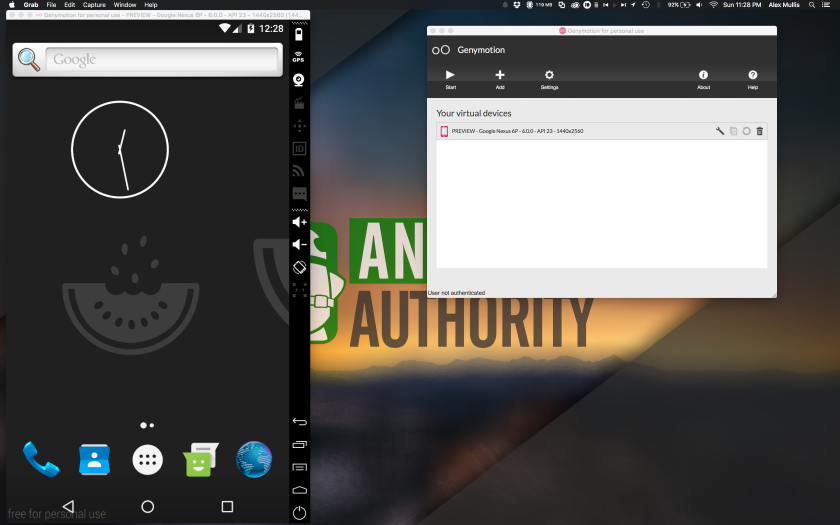
Genymotion is a legacy Android on PC project, offering pure Android emulation with thousands of configuration options available to tailor your experience. The software runs an Android Virtual Device from within VirtualBox, which you’ll also need to install.
One of Genymotion’s biggest draws is the simulation of GPS, camera, SMS & calls, multi-touch, and basically all the other familiar Android hardware features. Other features include ADB access, support for a variety of app testing frameworks, even cloud access through services like Amazon and Alibaba.
Remember though, Genymotion is primarily targeted at developers looking for an environment in which to test their applications. As such, it’s a professional environment with a selection of price plans to match. However, you can download and use the Personal Edition for free.
Open source Android x86.org Android on PC
Next on our list is a free open-source option – Android x86.org.
Based on the Android Open Source Project, Android-x86.org set out to make Android available to anyone with a PC. This makes Android x86 one of the best options if you’re looking to install the latest version of Android on PC and use it as your primary operating system or run it in a VM. The software offers near complete stock Android with no additions whatsoever, which is a mixed bag. The good news is that Google Play Services is installed by default, but using something made for touch on a desktop is not that intuitive.
Unfortunately, installation is a little more involved than some of the applications listed below. The standard method is to burn an Android-x86 version to a bootable CD or USB stick and install the Android OS directly to your hard drive. Alternatively, you can install Android-x86 to a Virtual Machine, such as VirtualBox, giving you access from within your regular operating system.
From inside your Virtual Machine, you can install the ISO file and then boot into the operating system. An official guide to the installation options for Android-x86 can be found here.
Old but gold – BlueStacks

BlueStacks is one of the longest-enduring methods to install Android on PC, founded in 2011 and still going strong. BlueStacks has impressive performance, though it’s not a patch on the Android Virtual Device. Additional features include: a simplified UI, optimizations dedicated to gaming, key-mapping, and multi-instance support to run multiple apps and even Google Accounts at once.
The user interface on Windows is more akin to what you would see in a web browser and offers quick app switching in a tab format on the top of the window. Those hoping to install their own launchers will be disappointed, however, as the option is no longer available since BlueStacks 4. On the plus side, BlueStacks also integrates with Windows to transfer files like APKs and there is even universal copy and paste.
BlueStacks remains a virtual machine at its core. So you don’t quite get native system performance, but this keeps the application simple to install and run. BlueStacks 4 runs on a 32-bit version of Android 7.1.2 Nougat, so it’s not the most up-to-date out of all the options out there. It is also heavily monetized, which some find distasteful: it will repeatedly request that you download apps from its partners, and you’ll need to pay a fee if you choose not to.
Even so, BlueStacks remains one of the best methods of running Android on PC out there. Check out what BlueStacks has to offer by clicking on the link below. You can download the platform at the bottom of the page.
One for the gamers – MEmu

If you’re after a simple way to run Android games on a Windows PC, MEmu might be the way to go. The Chinese software is ad-supported, which might be a put-off compared to alternatives. However, MEmu’s gaming-focused features might be worth it for some.
MEmu supports multiple-instances, allowing you to run several apps at once to level up multiple accounts. There’s also support for keyboard and mouse input as well as gamepads so you can play your way. Other functionalities include the ability to sideload apps and window resizing with a minimum sizing that prevents apps from becoming unusable.
In terms of performance, MEmu gained popularity as a faster emulator compared to BlueStacks 3. However, the race is much closer these days given BlueStack 4’s performance improvements. The latest MEmu version supports up to Android 7.1, with Android 5.1 and 4.4 compatibility included too.
There are a number of other game-focused clients that let you install Android on PC, including Gameloop (formerly Tencent Gaming Buddy), NoX, and others. Check out our list of the best Android emulators for more niche options.
Comparing the best options to install Android on PC
Each method has its advantages and disadvantages, but it really depends on what you want out of having Android on your desktop.
Bluestacks and other emulators like it have some baggage. Genymotion uses VirtualBox’s virtualization. Android-x86 works great as a proof of concept, but it isn’t that practical to use when comparing it to the other options discussed in this article.
On balance, this author finds installing the AVD Manager to be the optimal solution. While it comes packaged with Android Studio, the performance and flexibility are unmatched. Plus it is genuinely free, officially supported by Google, and constantly up-to-date. Hey Google! Why not release the virtual device separately?
Comparison of mobile operating systems
5+: 3rd party software[142]
5+: When an app that can handle/open the filetype is installed (excluding audio/video – requires 3rd party software[146]);[147]
6–8: Limited
Best Android OS for PC 64 bit or 32 bit in 2020 to download
There are only a couple of handful Android OS for PC available in the software market that can be installed either on the bare PC system or Virtual Machine for having the Android experience without compromising base OS such as Windows 10/8/7.
Android is now one of the popular operating systems available for small handheld devices like smartphones to big TVs. However, this smart OS somewhere still lacking behind when we talk about PC or Laptop computers. It is because Android-primarily meant for smartphones. Although, there are few good emulators available those let you virtually install the Android OS on the Windows operating system but not on a bare machine such as Bluestack and Memu. Moreover, you can also use the Virtual Machines to use the Android OS for both Windows 10 or Linux PC to experience it before installing it as your primary OS.
Best Android os for PC in 2020
In this article, we will talk about the free/opensource & best Android OS ( operating systems) for PC for both 64 bit & 32-bit systems.
Android-x86 Project – Run Android on Your PC
When it comes to run the latest Android OS for pc then the Android-x86 is one of the best open-source Android projects available for PC. Android-x86 OS project offers compatible ISO images for both 64-bit 32-bit computer systems. If you are about to install the Android OS on some old PC then it is recommended to download the 32-bit version… The latest Android OS they offer while writing this article was Android Oreo. The users can create a bootable USB drive with the Android-x86 to run it directly from the boot.
To get some feel like Windows OS, the user can Add the Taskbar which is a launcher that comes with OS to get Start menu and recent apps tray in landscape devices. Furthermore, as there are no sensors in our PC systems to sense the portrait mode or landscape, developers enabled the ForceDefaultOrientation to run all portraits apps in landscape mode by default.
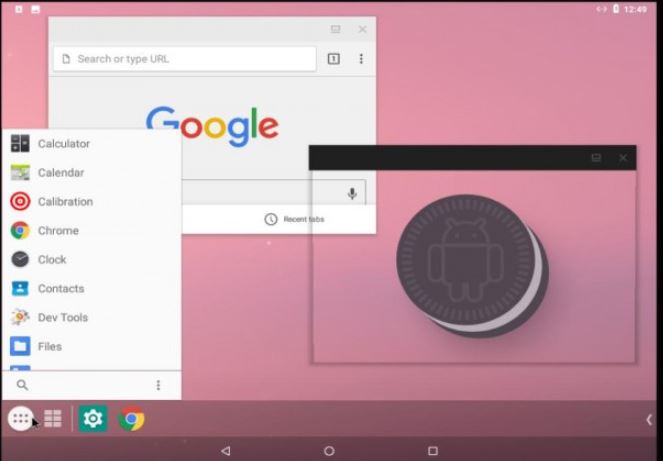
It supports both 64-bit and 32-bit kernel and userspace, OpenGL ES 3.x hardware acceleration for Intel/AMD/Nvidia, VMware and QEMU, OpenGL ES 2.0 via SwiftShader for software rendering on unsupported GPU devices, hardware-accelerated codecs on devices with Intel HD & G45 graphics family, secure booting from UEFI and installing to UEFI disk, Text-based GUI installer, Theme support to GRUB-EFI, Multi-touch, Audio, Wifi, Bluetooth, Sensors, Camera and Ethernet (DHCP only), Auto-mount external USB drive and sd card; Support arm arch apps via the native bridge mechanism. (Settings -> Android-x86 options). This Android OS for PC is an open-source project licensed under GNU General Public License (GPL) 2.0 or later.
Download:Android-x86 for PC
See: How to install Android-x86 for PC on Virtualbox or Vmware
Phoenix OS- Android OS for PC
It is another best Android-PC based operating system with a much familiar interface that is easy to use as the Windows 10. The Phoenix OS’s current version is based on Android 7.1. It supports the keyboard and mouse in the same way as we use in the Windows, macOS, or Linux PCs. It also features a few retro features such as desktop, multi-window, mouse, and keyboard operation, etc.
Furthermore, Phoenix supports shortcut keys such as Ctrl+C, Win+D, Alt+Tab, and Alt+F4. Beside common peripheral devices support it also has the ethernet compatibility to obtain an IP address automatically, manually configure IP, DNS, gateway, etc. You don’t need to download Parallel apps like applications to create dual instances of apps like Whatsapp, Instagram, etc.
It has an inbuilt function for that even a user can run identical apps in multiple windows cumulatively. To save the processing power the Phoenix system uses a strict management strategy. Phoenix Android OS for PC also imposes strict restrictions on implicit broadcast and background wake-up mechanism, which can effectively prevent the application from self-starting or waking up the device.
It has a multi-browsing capability like PC and features the AD blocker too including three different user interfaces. For productive tasks, this Android OS for PC comes with a pre-installed version of WPS offices suite, Ever note and other applications to create documents, excel sheets, manage emails, and more with large screen support…
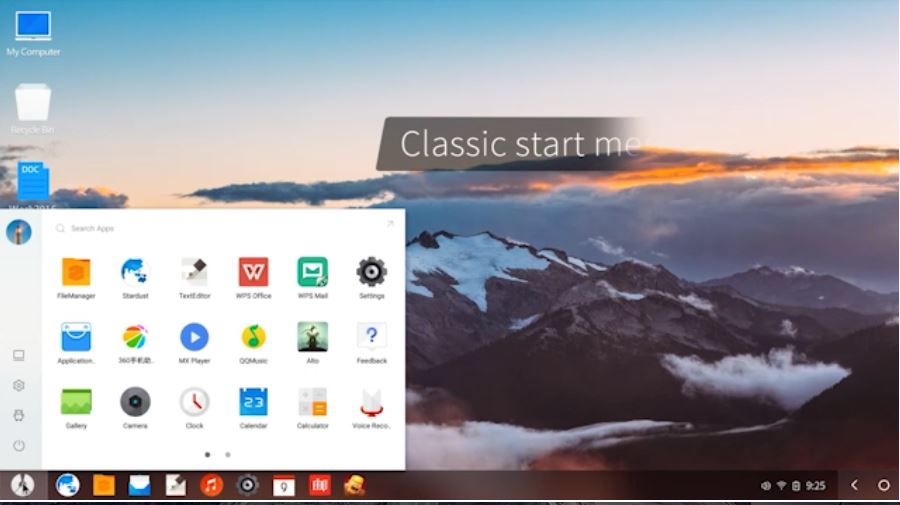
You can even play games like Pubg, Asphalt, Fortnite directly on the PC with keyboard and mouse. The File management, Global search, built-in archiving and unarchiving support, LAN and Drag and drop support are also there. The Phoenix available in multiple formats one is for Desktop and other for tablets. It can be downloaded in the form of ISO image as well as .exe executable file for Windows.
See: Install Phoenix OS in Dual boot with Windows 10/7
BlissOS
BlissOS Android operating system developed by a team effort of different developers such as Chainfire, CM/LineageOS, Android-x86, Jide, and the others. The BlissOS is for your x86-based devices which include desktops, laptops, tablets, maker boards, and a lot more. It supports both BIOS/CSM and UEFI boot.
The builds of the BlissOs are compatible with PC, MacBooks, and Chromebooks come with CPUs from Intel and AMD, and GPUs from Intel, AMD, or Nvidia.
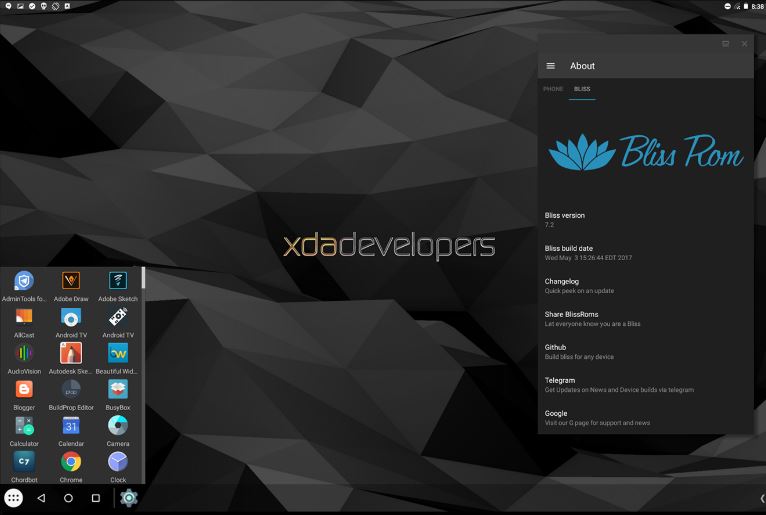
To give the more desktop-like feel the developers have integrated the Taskbar launcher developed by the farmerbb along with orientation app that force installed apps to start in the landscape mode. For gamers, the BlissOS includes Octopus. TheOctopus is a solution that allows users to map the on-screen controls with gamepads, mouses, keyboards, developed by the Phoenix OS team. It can be downloaded separately to work with the above mentioned Android OS for PC too. However, it is still on its beta stage and also has glitches.
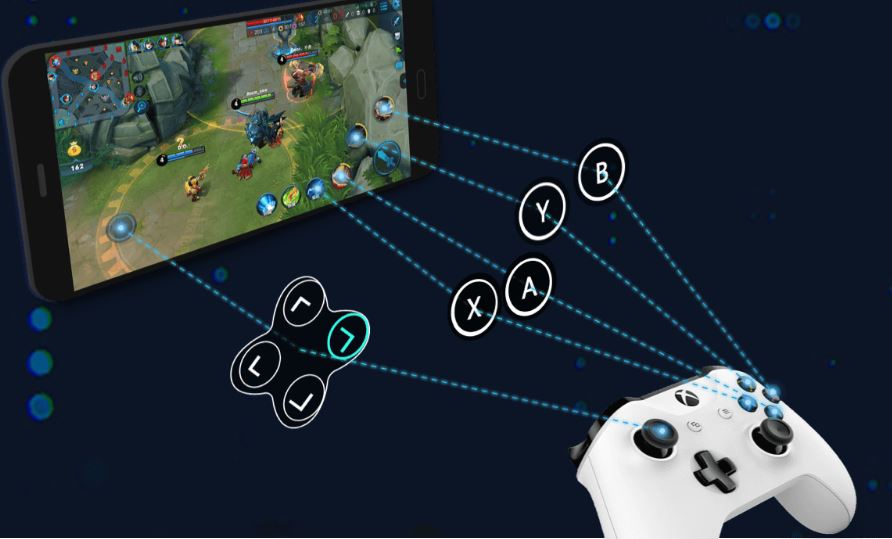
Download BlissOS for PC from Sourceforge and Official website.
See: How to install Bliss os X86 on PC and VirtualBox
OpenThos Android OS
OpenThos is the Android-based operating system that can provide a full-fledged Android X86 experience on PC with additional apps and functions. It is based on free and open-source (Foss) Android OS called Android-X86, although the base of both PC Android operating systems is the same, look and feel is quite different. The OpenThos looks very professional with Windows 10 like interfaces such as Taskbar, My computer icon, and right side notification panel.
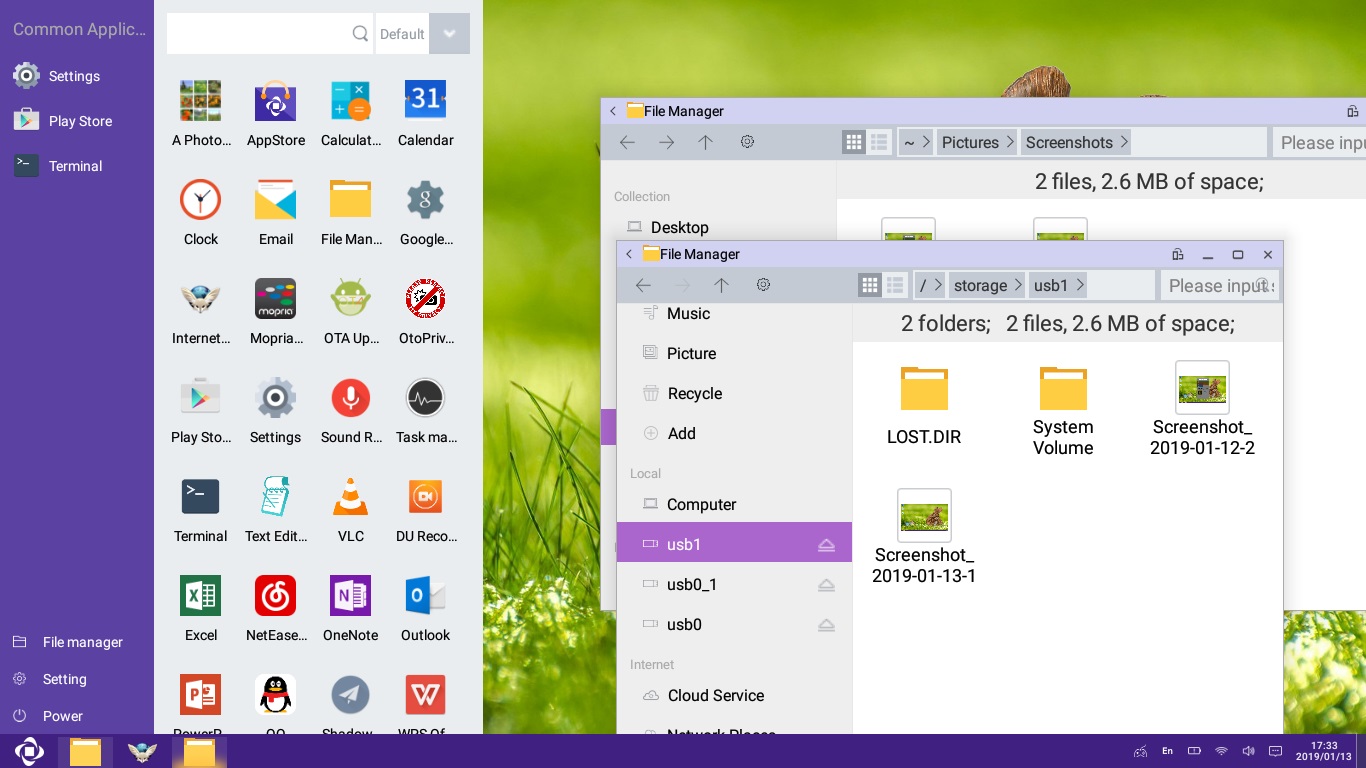
Know more about it:How to install OpenThos and Review
PrimeOS
PrimeOS is an Android-based OS for Laptop/PC. It is also based on the opensource Android x86 project. It enables you to experience Android with a complete desktop interface. PrimeOS supports the whole Android application ecosystem with the multiwindow feature.
PrimeOS is also equipped with a key mapping tool that lets you set Android games controls to keyboard/mouse. Now play any Android game on any PC and make the highest score ever. It can converts your PC into an Android Machine with a much better experience than an emulator.
The System Requirements for PrimeOS are: It supports a wide range of Intel/AMD based processors both 32-bit & 64-bit instruction system and UEFI & Legacy boot too. The minimum RAM it needs is 2GB and Storage is minimum 6GB.

Download PrimeOS ISO
Remix OS (Dead Almost)
Note: The Remix OS has discontinued Android OS for PC and now getting no more updates. The developers have abandoned it to work on some other enterprise project, however, it is still available on the website to download.
It was one of the best Android OS and if someone wants to experience it then he/she can. It is available for personal computers with x86 and ARM architectures. It allowed PC users to run Android mobile apps on any compatible Intel-based PC. The Remix OS is based on Android-x86 and available to free download, it supports 32-bit & 64-bit systems and UEFI boot. The system requirements of Remix OS is 2 GHz dual-core processor(at least), 2 GB system memory, and a minimum 8 GB of free hard drive space. The last update of this Android OS for PC was based on Android Marshmallow.
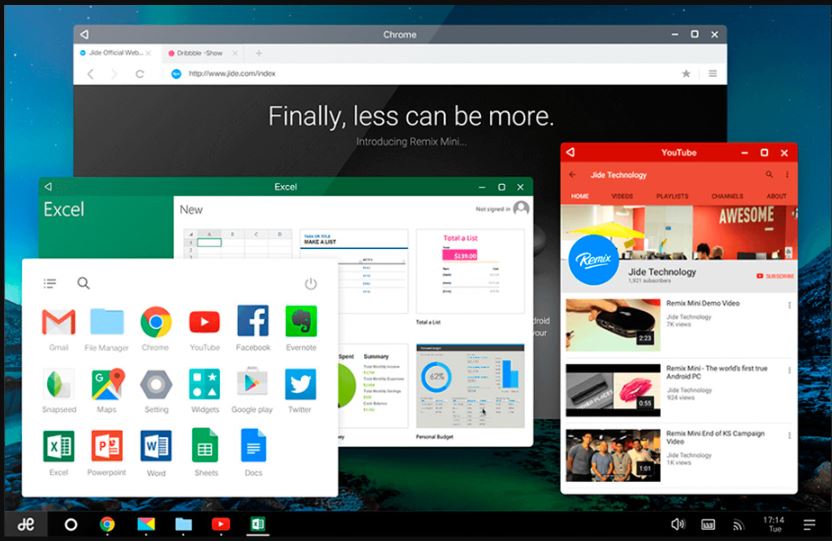
Download Remix OS
Few other options to run Android on PC.
Maru
Maru introduced a different approach to run Android on PC. It is available for some selected smartphones as firmware that once installed on the smartphone; it can be used as both smartphones and when connects to PC gives a complete desktop experience. Your phone runs independently of your desktop so you can take a call and work on your big screen at the same time. Just like the Samsung DeX.
You can read more about on their official website.
Shashlik
This is not an Android OS as mentioned above but an approach to run the Android applications on the Linux desktops in the easiest form. It’s a Linux base that we can nest inside our session. OpenGL and graphics are all rendered on the host ensuring fast performance. Shashlik provides an incredibly stripped-down Android base which boots directly into the loaded app, but with a running activity manager and daemons so that intents still work correctly.
Know more Shashlik
Furthermore, you can see the best available emulators to run the Android on PC not natively but virtually: 10 Best Android Emulators For Windows 10 and Mac PC
Other Useful Resources
What’s New in the Best Android Os For PC Archives?
Screen Shot

System Requirements for Best Android Os For PC Archives
- First, download the Best Android Os For PC Archives
-
You can download its setup from given links:


